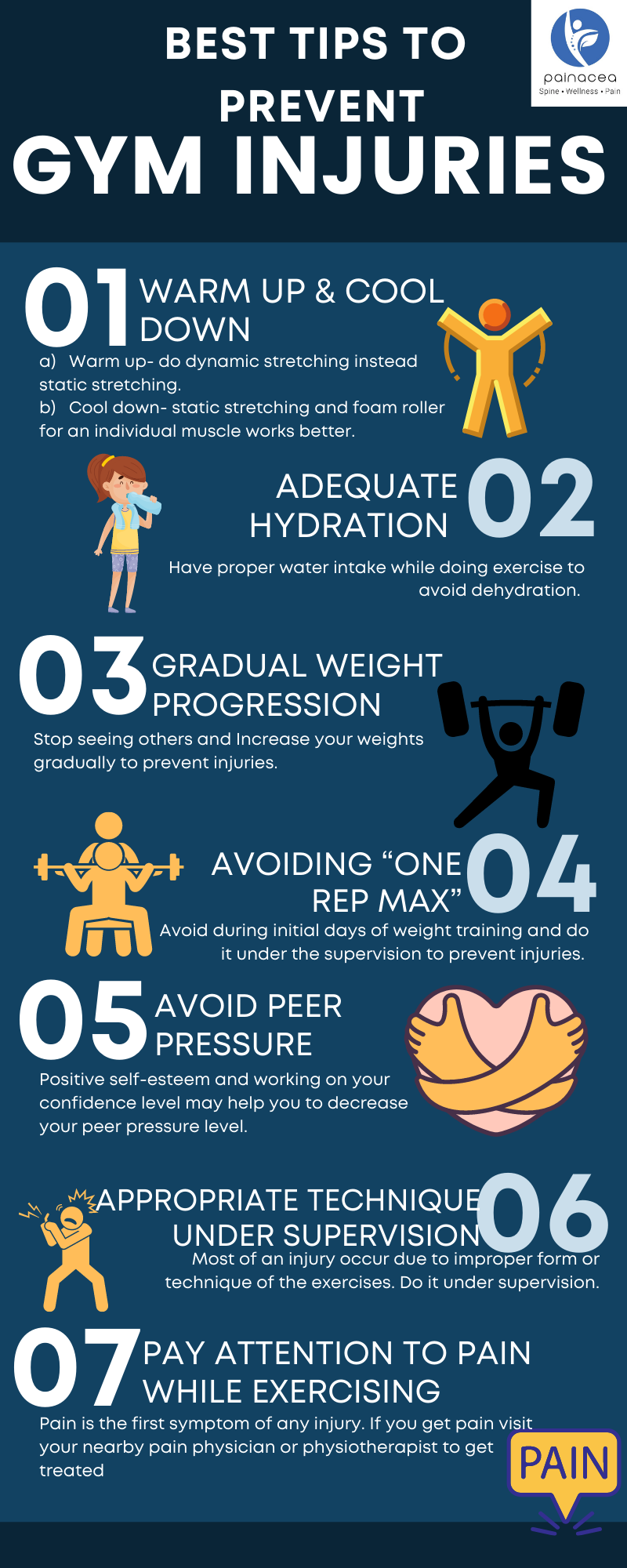Gym induced Injuries in Men
- Painacea Team

- Nov 27, 2020
- 3 min read
Updated: Feb 4, 2022
The use of weights is an increasingly popular conditioning technique in competitive sports and recreational activity among children, adolescents and young adults. Weight training because of lack of knowledge or due to wrong form can lead to several injuries. This article will explain what are these “Gym Injuries” and how they can be prevented.
Weight-training can cause significant musculoskeletal injuries such as fractures, dislocations, spondylolysis, spondylolisthesis, intervertebral disc herniation, and meniscal injuries of the knee. Some people choose resistance training as their primary source of exercise and others as a secondary regimen in order to improve performance in another sporting activity (like cricketers going to gym!).

Both powerlifters and Olympic weightlifters seem to experience low-back muscular strains at a higher rate than bodybuilders.
Out of all injuries in the gym, injuries due to free weights (dropping or otherwise) is approximately 90%. Studies have shown that among these injuries, sprain/strain injury is the most common injury (46% of injuries). Approximately 65% the most common mechanism is dropping of a free weight. These injuries may be Acute or Chronic
ACUTE INJURIES
Different sports have different injuries. Strength training is the most common sport practised in a Gym. Muscular strains and ligament sprains is around 46%-60% of all acute injuries in strength training. For example, powerlifters more commonly injure their shoulders, while weightlifters more commonly injure their elbows and knees. Both powerlifters and Olympic weightlifters seem to experience low-back muscular strains at a higher rate than bodybuilders. In the competition, Shoulder and elbow dislocations occur in the snatch compared with the clean and jerk due to two factors, the wider nature of the grip and the more aggressive rotation or over rotation of the shoulder. Commoners who do these activities also experience similar injuries depending on the technique / duration of the activity and mechanism of the injury.
Emergency injuries include acute herniated discs, fractures, dislocations, myocardial infarction, and spontaneous pneumothorax. These emergency injuries require immediate transfer to a medical facility.
Non Emergency acute injuries, by contrast, are the most common chief complaint at competitions and even commoners / hobby players are affected. They often either do not stop an individual from continuing (e.g., small lacerations, mild strains) or result in only a brief respite from activity ( less than 5 days).
CHRONIC INJURIES
Chronic type injuries tend to be of the overuse type, and which is approximately 30% of injuries associated with strength training. 12%-25% of all strength training injuries, tendinopathies (e.g., acute tendonitis or chronic tendi
nosis) can have a significant impact on training time.

Good coaching and proper weightlifting techniques and other injury prevention methods are likely to minimise the number of musculoskeletal problems caused by weight-training. Here are 7 best tips to prevent these injuries:
Warm Up & Cool Down-
Warm Up - dynamic stretching increases the performance of an individual as compared to static stretching.
Cool Down - static stretching for an individual muscle as well as foam roller muscle release is the best way to reduce post workout muscle soreness.
Adequate hydration and diet- It is important to have proper water intake while doing exercise to avoid dehydration. If you're doing moderate to high intensity exercise it is important to have carbohydrates food before the workout (which acts as fuel for the exercises )and post workout protein rich food for muscle recovery.
Gradual weight progression- Research has shown, most injuries occur due to lifting heavy weights without progression. Stop seeing others who lift more weight than you because he might be doing this for a very long time. It is important to increase your weight gradually to prevent injuries.
Avoiding “One Rep Max” and concentrating on- During the initial days of weight training try to avoid 1RM training. For 1RM training, warm up exercises for 2- 3 sets of 4-8 reps are very important which has to be very specific to exercise and during the starting of your gym days if you really want to do 1RM training take knowledge from experts and you can do it under the supervision of a gym trainer to prevent injuries.
Avoid Peer pressure- Try to avoid peer pressure initial time of the gym. Be patience and believe in yourself. Make good choices of friends in the gym who are positive and motivate you. Positive self-esteem and working on your confidence level may help you to decrease your peer pressure level.
Appropriate technique under supervision- In the gym most of an injury occur due to improper form or technique of the exercises. It is very important if you're a newcomer to the gym, it is safe if you do weight training under the supervision of the expers trainer to avoid injuries.
Pay attention to Pain while exercising- Pain is the first symptom of any injury. If you get any kind of pain except your muscle soreness pain, visit your nearby pain physician or physiotherapist to get treated.

Reference




Comments